Yesterday’s summary advised members to take the alternate Elliott wave count seriously. A new low below 2,931 invalidated the main Elliott wave count and provided confidence in the alternate Elliott wave count. At that stage, the targets were 2,923 or 2,898.47. A low for the session at 2,874.93 saw both targets met and passed.
Summary: The trend for the short term is down until proven otherwise. Proven otherwise would be any one of either:
– A new high above 2,952.86.
– A 90% up day.
– Two back to back 80% up days.
– A bullish candlestick reversal pattern with support from volume.
The main wave count expects the pullback is over here or very soon indeed.
A new low below 2.822.12 would invalidate the main wave count and add confidence to an alternate. Expect price at that stage to keep falling to 2,578 – 2,476 to find support at the lower edge of the large teal channel on weekly and daily charts.
The biggest picture, Grand Super Cycle analysis, is here.
Monthly charts were last published here, with video here. There are two further alternate monthly charts here, with video here.
ELLIOTT WAVE COUNTS
The two weekly Elliott wave counts below will be labelled First and Second. They may be about of even probability. When the fifth wave currently unfolding on weekly charts may be complete, then these two wave counts will diverge on the severity of the expected following bear market. To see an illustration of this future divergence monthly charts should be viewed.
FIRST WAVE COUNT
WEEKLY CHART
The basic Elliott wave structure consists of a five wave structure up followed by a three wave structure down (for a bull market). This wave count sees the bull market beginning in March 2009 as an incomplete five wave impulse and now within the last fifth wave, which is labelled cycle wave V. This impulse is best viewed on monthly charts. The weekly chart focusses on the end of it.
Elliott wave is fractal. This fifth wave labelled cycle wave V may end a larger fifth wave labelled Super Cycle wave (V), which may end a larger first wave labelled Grand Super Cycle wave I.
The teal Elliott channel is drawn using Elliott’s first technique about the impulse of Super Cycle wave (V). Draw the first trend line from the end of cycle wave I (off to the left of the chart, the weekly candlestick beginning 30th November 2014) to the end of cycle wave III, then place a parallel copy on the end of cycle wave II. This channel perfectly shows where cycle wave IV ended at support. The strongest portion of cycle wave III, the end of primary wave 3, overshoots the upper edge of the channel. This is a typical look for a third wave and suggests the channel is drawn correctly and the way the impulse is counted is correct.
Within Super Cycle wave (V), cycle wave III is shorter than cycle wave I. A core Elliott wave rule states that a third wave may never be the shortest. For this rule to be met in this instance, cycle wave V may not be longer in length than cycle wave III. This limit is at 3,477.39.
Cycle wave V may subdivide either as an impulse or an ending diagonal. Impulses are much more common. This main wave count expects that cycle wave V may be unfolding as an impulse.
The daily charts below will focus on all of cycle wave V.
In historic analysis, two further monthly charts have been published that do not have a limit to upwards movement and are more bullish than this wave count. Members are encouraged to consider those possibilities (links below summary) alongside the wave counts presented on a daily and weekly basis.
MAIN DAILY CHART
Primary wave 3 may have begun.
All of primary wave 3, intermediate wave (3) and minor wave 3 may only subdivide as impulses. Within each impulse, its second wave correction may not move beyond the start of its first wave.
Minor wave 2 may not move beyond the start of minor wave 1 below 2,822.12.
Intermediate wave (3) must move far enough above the end of intermediate wave (1) to then allow intermediate wave (4) to unfold and remain above intermediate wave (1) price territory.
HOURLY CHART
If a second wave correction is unfolding lower, then it would most likely subdivide as a zigzag.
It is possible that minor wave 2 could be over at today’s low. But this wave count requires a new high above 2,952.86 or support from technical analysis for confidence.
Minute wave c would be 5.74 points longer than 1.618 the length of minute wave a if it is over at today’s low.
There is still room for minute wave c to extend lower. Minor wave 2 may not move beyond the start of minor wave 1 below 2,822.12.
ALTERNATE DAILY CHART
This wave count has been published before. It remains valid, and now is time to again consider this possibility.
Cycle wave V may be subdividing as an ending diagonal. Within ending diagonals, all sub-waves must subdivide as zigzags. Primary wave 1 may be over at the last all time high as a zigzag.
Primary wave 2 must complete lower as a zigzag.
The second and fourth waves within diagonals are usually very deep, commonly between 0.81 to 0.66 the depth of the prior wave. This gives a target zone for primary wave 2.
Primary wave 2 may end if it comes down to find support at the lower edge of the teal channel, which is copied over from monthly and weekly charts. This trend line should provide final support for a deeper pullback.
Primary wave 2 may not move beyond the start of primary wave 1 below 2,346.58.
ALTERNATE HOURLY CHART
Intermediate wave (C) must subdivide as a five wave structure, most likely an impulse. So far within the impulse, minor waves 1 through to 3 may be complete.
Minor wave 3 is 5.74 points longer than 1.618 the length of minor wave 1.
Minor wave 4 may not move into minor wave 1 price territory above 2,952.86.
Minor wave 2 was a deep 0.57 expanded flat correction. Given the guideline of alternation, minor wave 4 may be expected to be shallow and most likely a zigzag, triangle or combination. Minor wave 4 should last at least one session and likely a few so that it shows up on the daily chart, giving intermediate wave (C) a five wave look at higher time frames.
SECOND WAVE COUNT
WEEKLY CHART
This weekly chart is almost identical to the first weekly chart, with the sole exception being the degree of labelling.
This weekly chart moves the degree of labelling for the impulse beginning in March 2009 all down one degree. This difference is best viewed on monthly charts.
The impulse is still viewed as nearing an end; a fifth wave is still seen as needing to complete higher. This wave count labels it primary wave 5.
TECHNICAL ANALYSIS
WEEKLY CHART
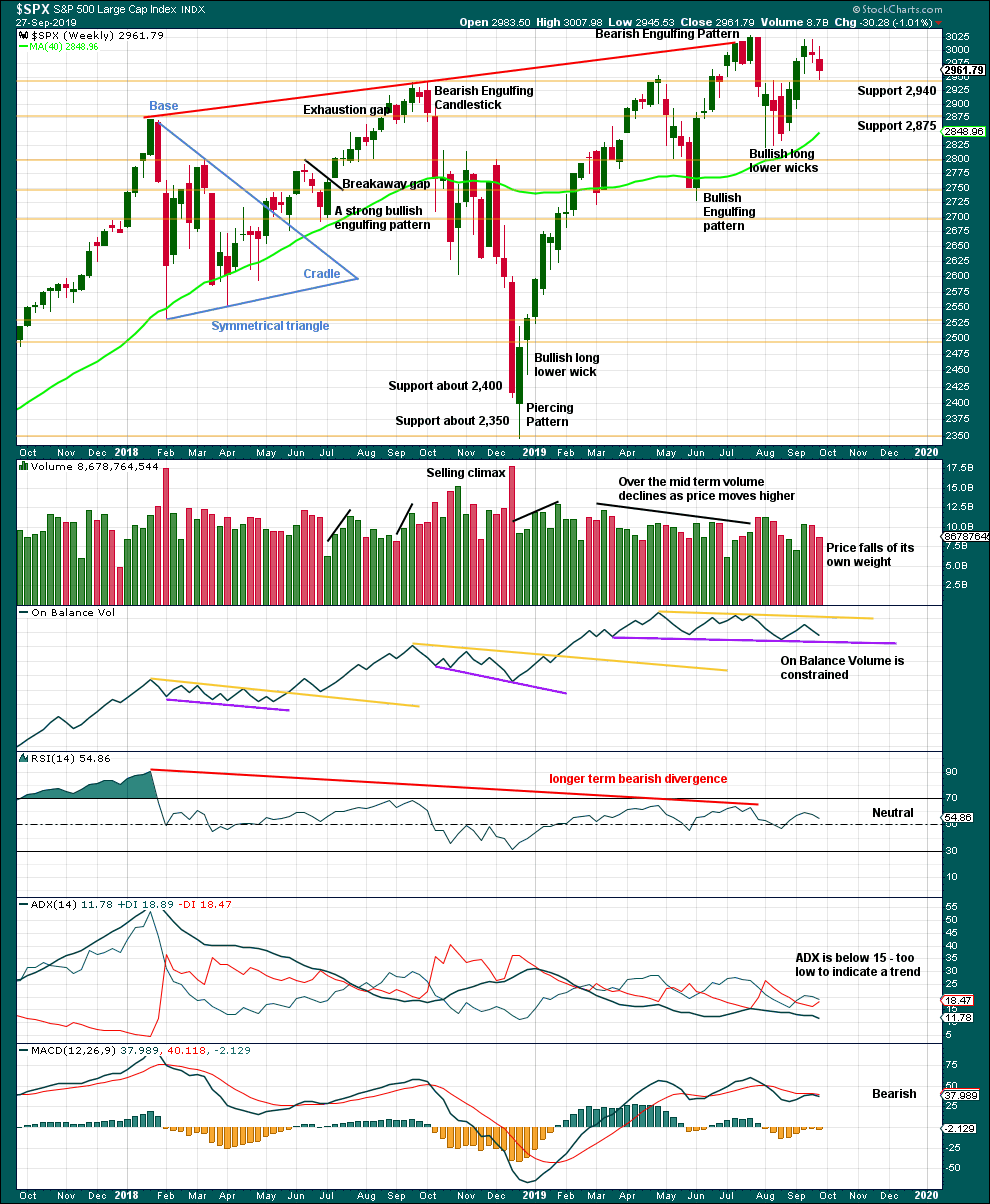
Click chart to enlarge. Chart courtesy of StockCharts.com.
There is no bearish candlestick reversal pattern in the last three weekly candlesticks. A decline in volume last week with a small range real body is slightly bullish. This looks like a small pullback within an ongoing upwards trend.
DAILY CHART
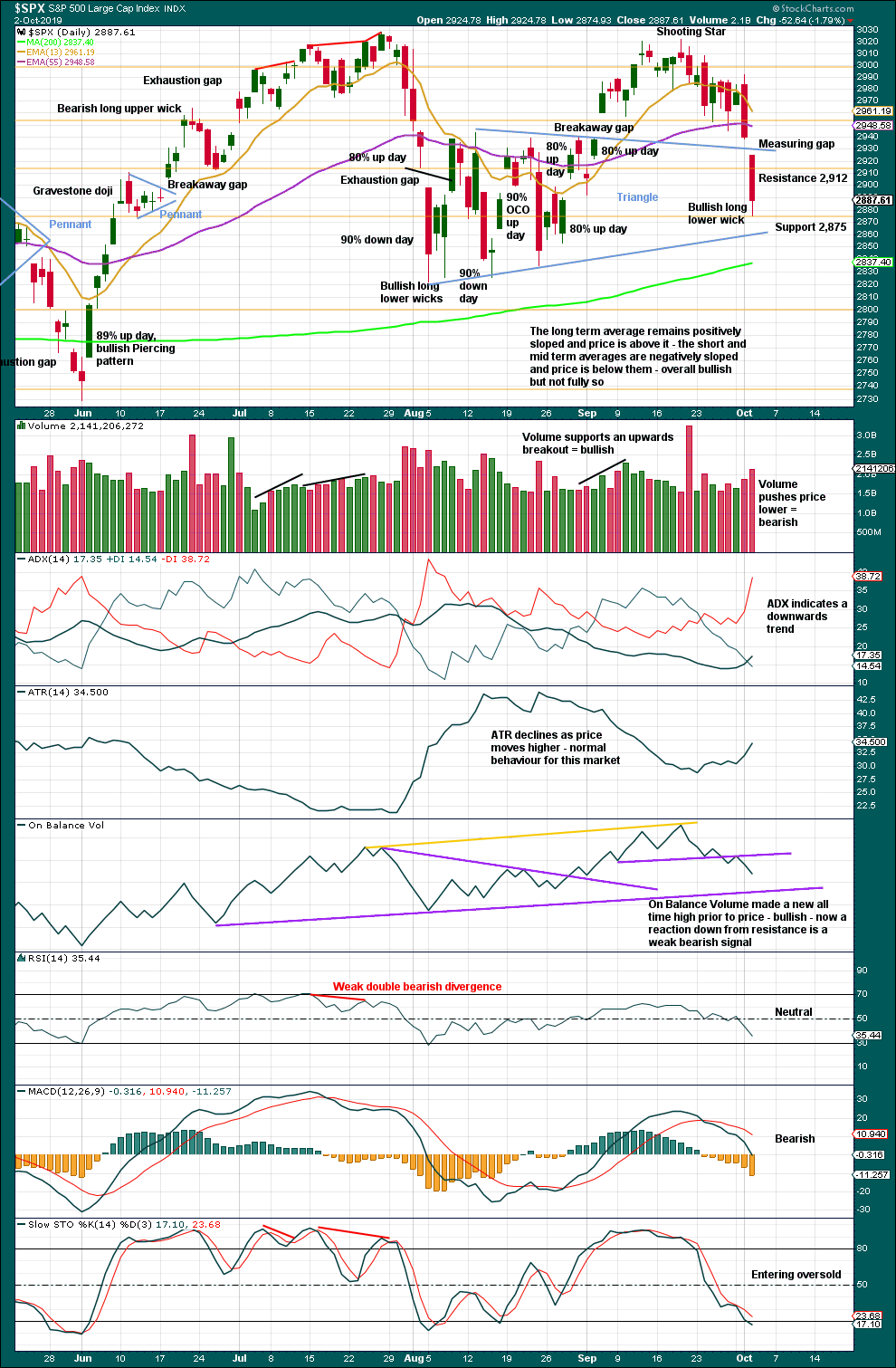
Click chart to enlarge. Chart courtesy of StockCharts.com.
There is now a series of higher highs and higher lows since the 5th of August. Strength in 90% up days and back to back 80% up days off lows indicate the lows may still be sustainable.
At this stage, for the short term at least, there is a new downwards trend in place. Next support is about 2,800 if support here at 2,875 can be overcome.
For confidence that a low is in place any one of the following shall be looked for:
– A 90% up day.
– Two back to back 80% up days.
– A bullish candlestick reversal pattern with support from volume.
BREADTH – AD LINE
WEEKLY CHART
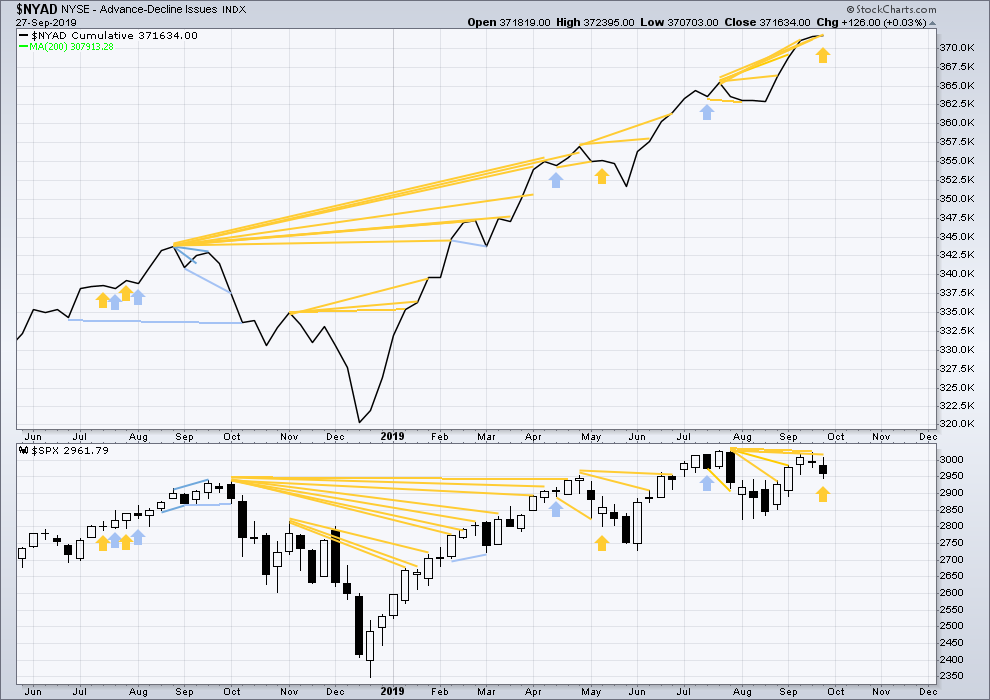
Click chart to enlarge. Chart courtesy of StockCharts.com. So that colour blind members are included, bearish signals
will be noted with blue and bullish signals with yellow.
Bear markets from the Great Depression and onwards have been preceded by an average minimum of 4 months divergence between price and the AD line with only two exceptions in 1946 and 1976. With the AD line making new all time highs again this week, the end of this bull market and the start of a new bear market is very likely a minimum of 4 months away, which is end January 2020.
In all bear markets in the last 90 years there is some positive correlation (0.6022) between the length of bearish divergence and the depth of the following bear market. No to little divergence is correlated with more shallow bear markets. Longer divergence is correlated with deeper bear markets.
If a bear market does develop here, it comes after no bearish divergence. It would therefore more likely be shallow.
Last week price has moved lower, but the AD line has moved slightly higher to make a slight new all time high. This divergence is strongly bullish and supports the main Elliott wave count.
Small caps have made a new swing high above the prior high of the end of July, but mid and large caps have not yet done so. This upwards movement of the last four weeks appears to be led by small caps. Because small caps are usually the first to exhibit deterioration in the later stages of a bull market, some strength in small caps at this stage indicates a healthy bull market with further to run.
DAILY CHART
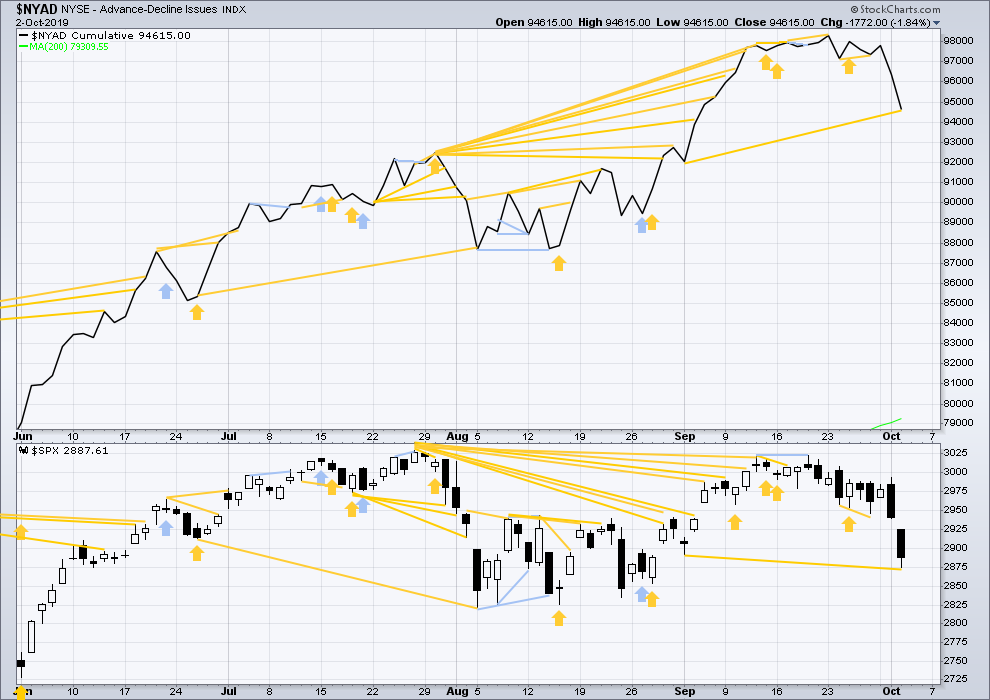
Click chart to enlarge. Chart courtesy of StockCharts.com. So that colour blind members are included, bearish signals
will be noted with blue and bullish signals with yellow.
Breadth should be read as a leading indicator.
Today both price and the AD line have moved strongly lower. Price has made a new swing low below the prior low of the 3rd of September, but the AD line has not. Price is falling faster than breadth. This divergence is bullish.
VOLATILITY – INVERTED VIX CHART
WEEKLY CHART
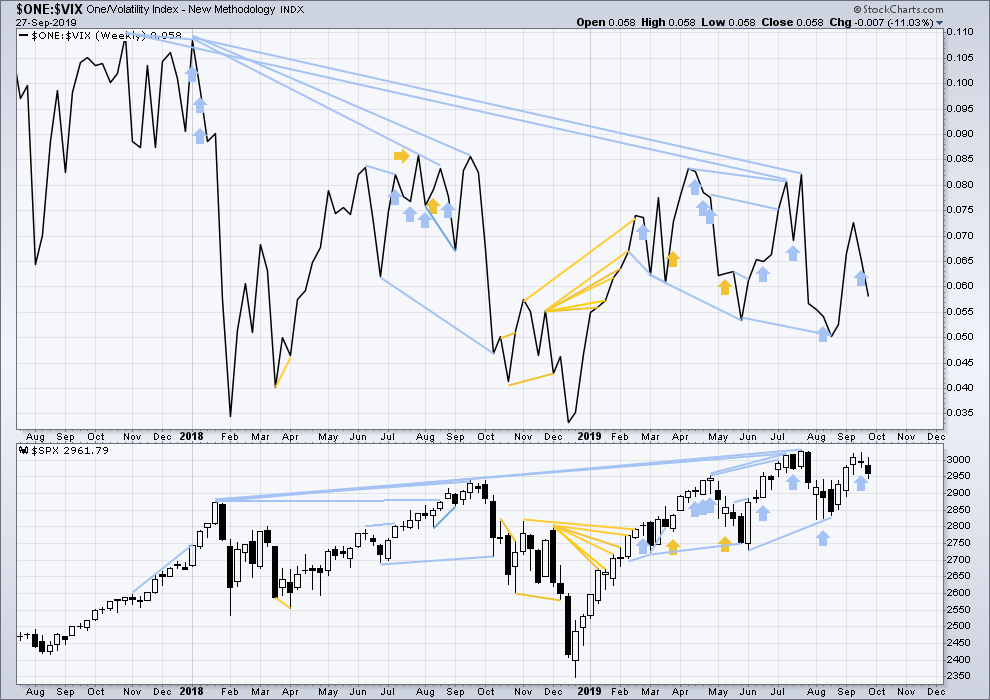
Click chart to enlarge. Chart courtesy of StockCharts.com. So that colour blind members are included, bearish signals
will be noted with blue and bullish signals with yellow.
The all time high for inverted VIX (which is the same as the low for VIX) was on 30th October 2017. There is now nearly one year and eleven months of bearish divergence between price and inverted VIX.
The rise in price is not coming with a normal corresponding decline in VIX; VIX remains elevated. This long-term divergence is bearish and may yet develop further as the bull market matures.
This divergence may be an early warning, a part of the process of a top developing that may take years. It may not be useful in timing a trend change.
Last week both price and inverted VIX moved lower. There is no new short-term divergence.
DAILY CHART
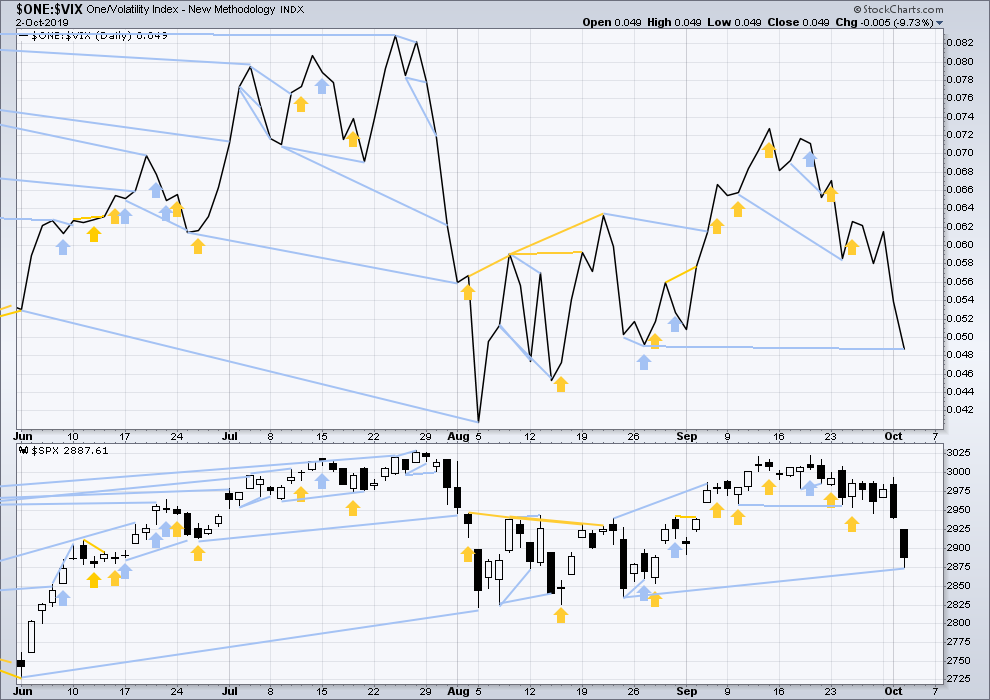
Click chart to enlarge. Chart courtesy of StockCharts.com. So that colour blind members are included, bearish signals
will be noted with blue and bullish signals with yellow.
Both price and inverted VIX have moved strongly lower today. Inverted VIX has made a new swing low below the prior low of the 23rd / 27th of August, but price has not. VIX is rising faster than price. This divergence is bearish, but it is slight.
DOW THEORY
Dow Theory confirmed a bear market in December 2018. This does not necessarily mean a bear market at Grand Super Cycle degree though; Dow Theory makes no comment on Elliott wave counts. On the 25th of August 2015 Dow Theory also confirmed a bear market. The Elliott wave count sees that as part of cycle wave II. After Dow Theory confirmation of a bear market in August 2015, price went on to make new all time highs and the bull market continued.
DJIA: 23,344.52 – a close on the 19th of December at 23,284.97 confirms a bear market.
DJT: 9,806.79 – price has closed below this point on the 13th of December.
S&P500: 2,532.69 – a close on the 19th of December at 2,506.96 provides support to a bear market conclusion.
Nasdaq: 6,630.67 – a close on the 19th of December at 6,618.86 provides support to a bear market conclusion.
With all the indices having moved higher following a Dow Theory bear market confirmation, Dow Theory would confirm a bull market if the following highs are made:
DJIA: 26,951.81 – a close above this point has been made on the 3rd of July 2019.
DJT: 11,623.58 – to date DJT has failed to confirm an ongoing bull market.
S&P500: 2,940.91 – a close above this point was made on the 29th of April 2019.
Nasdaq: 8,133.30 – a close above this point was made on the 26th of April 2019.
Published @ 11:15 p.m. EST.
—
Careful risk management protects your trading account(s).
Follow my two Golden Rules:
1. Always trade with stops.
2. Risk only 1-5% of equity on any one trade.
—
New updates to this analysis are in bold.

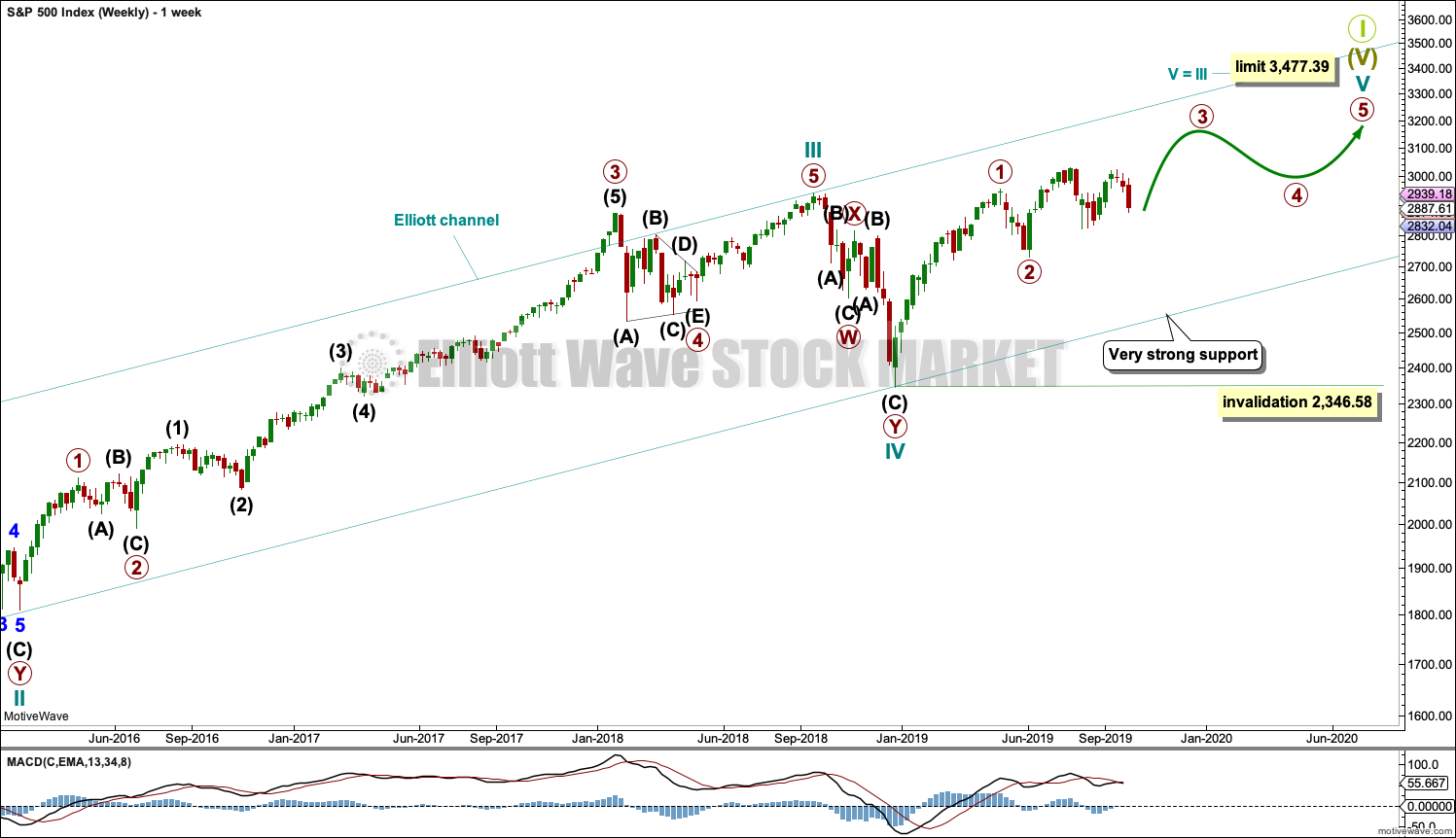
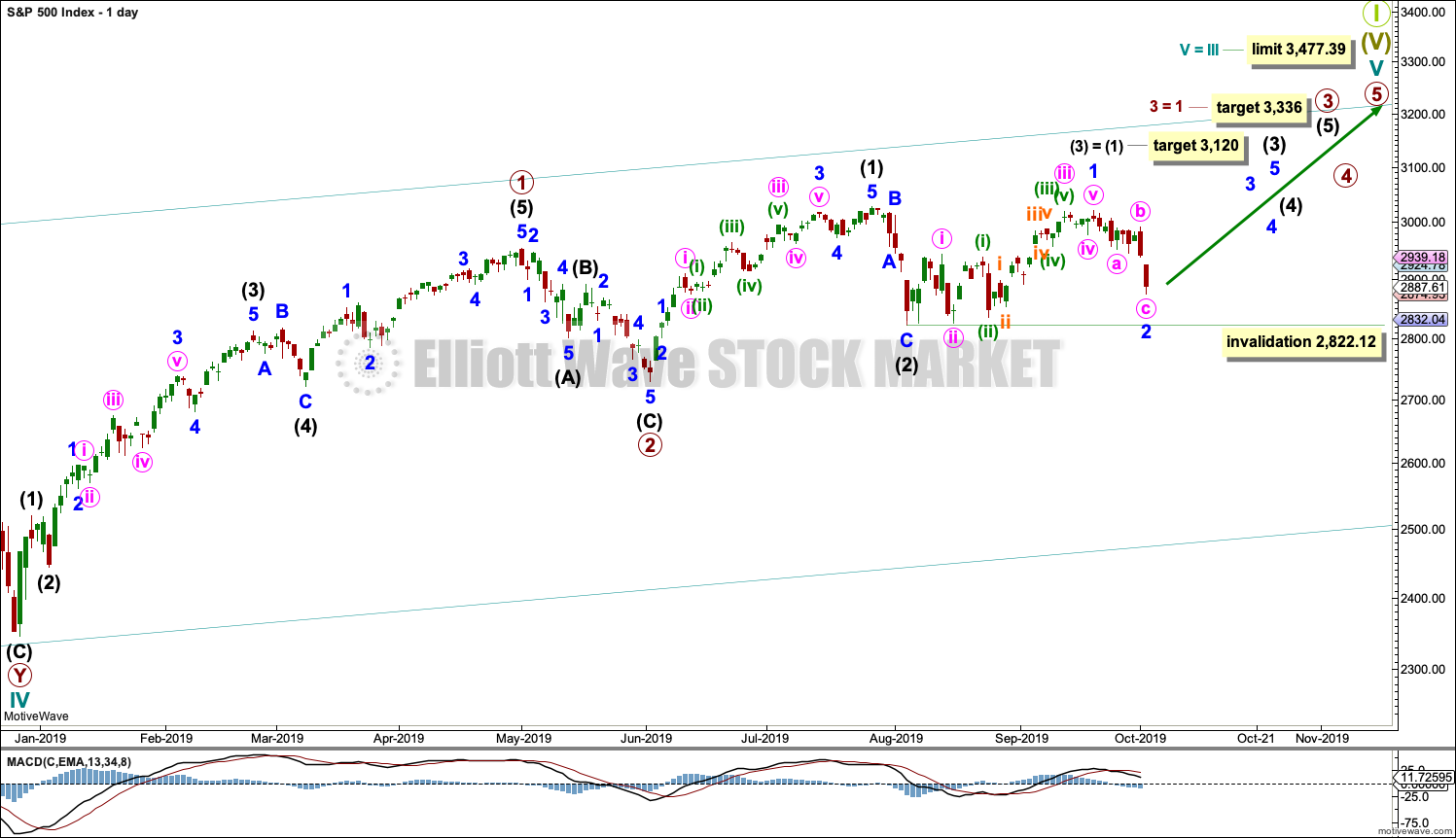
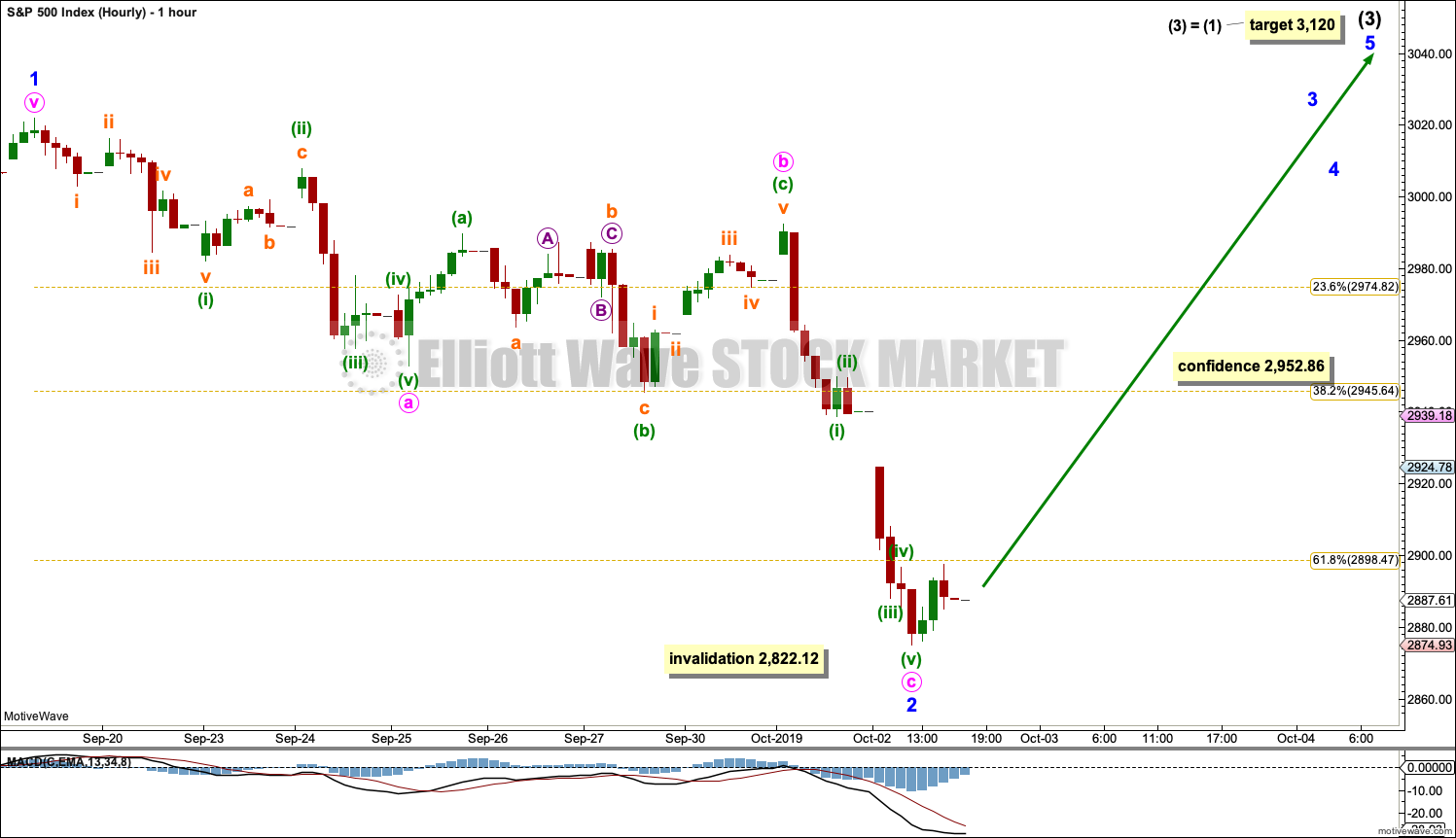
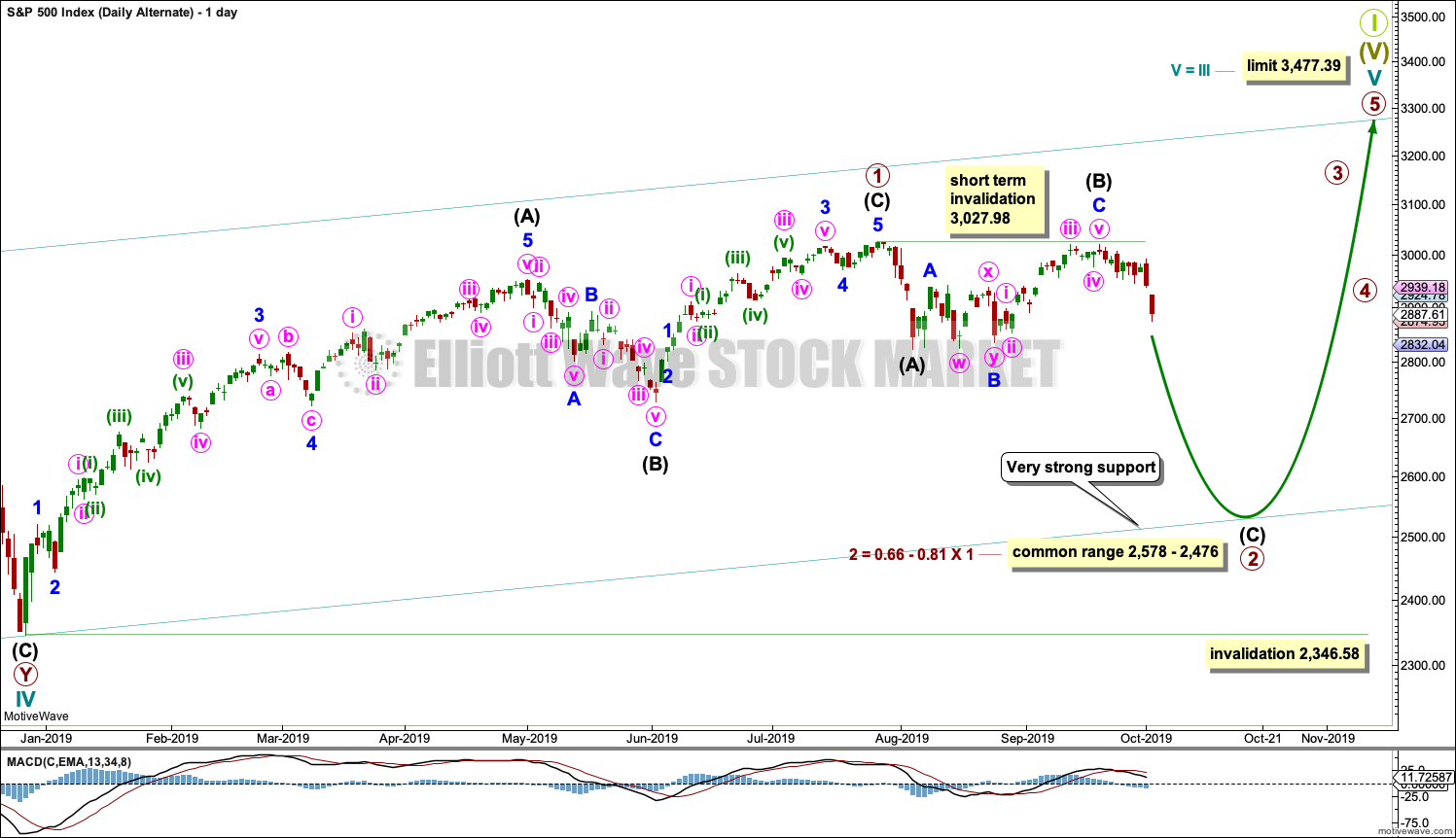
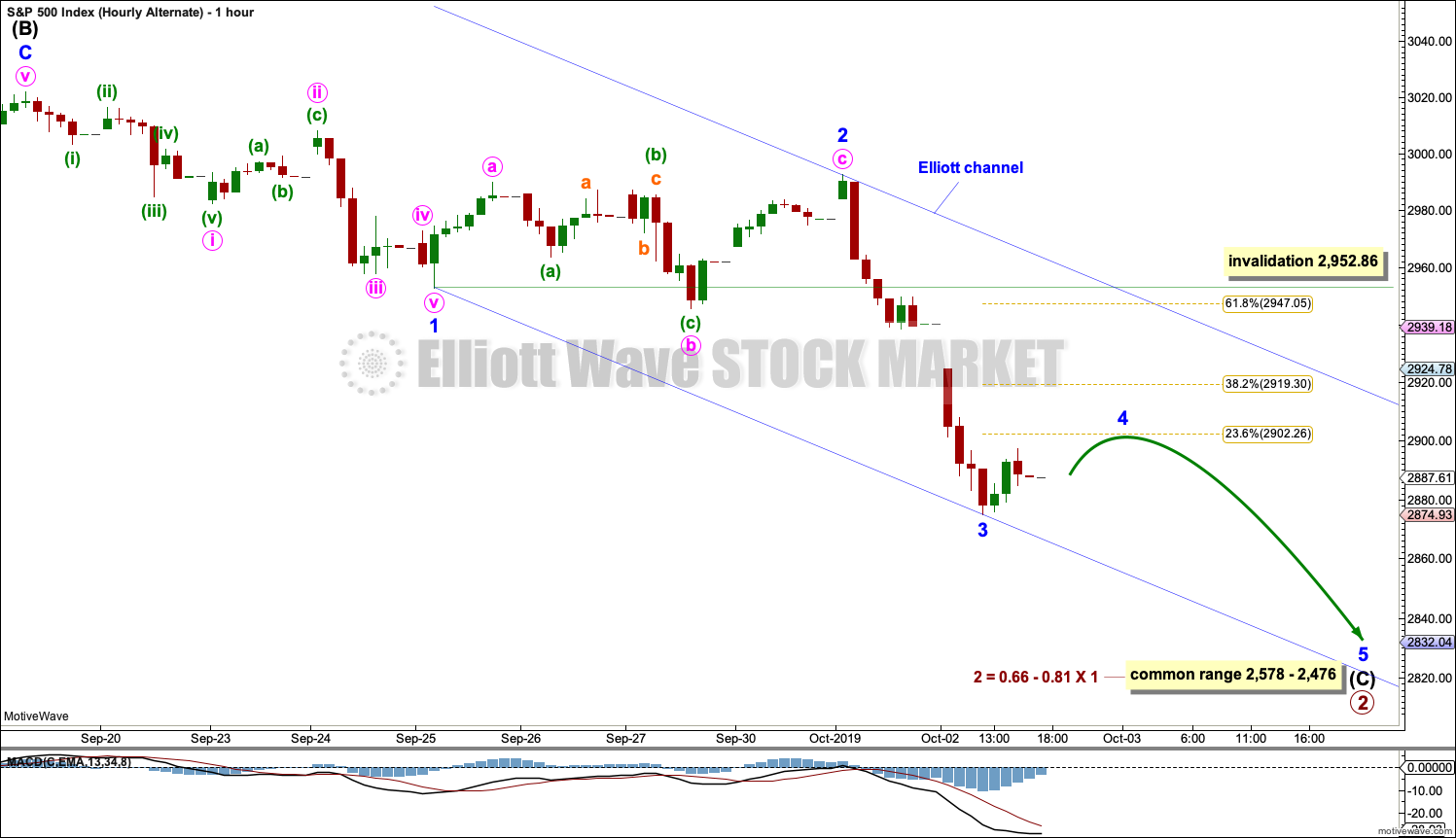
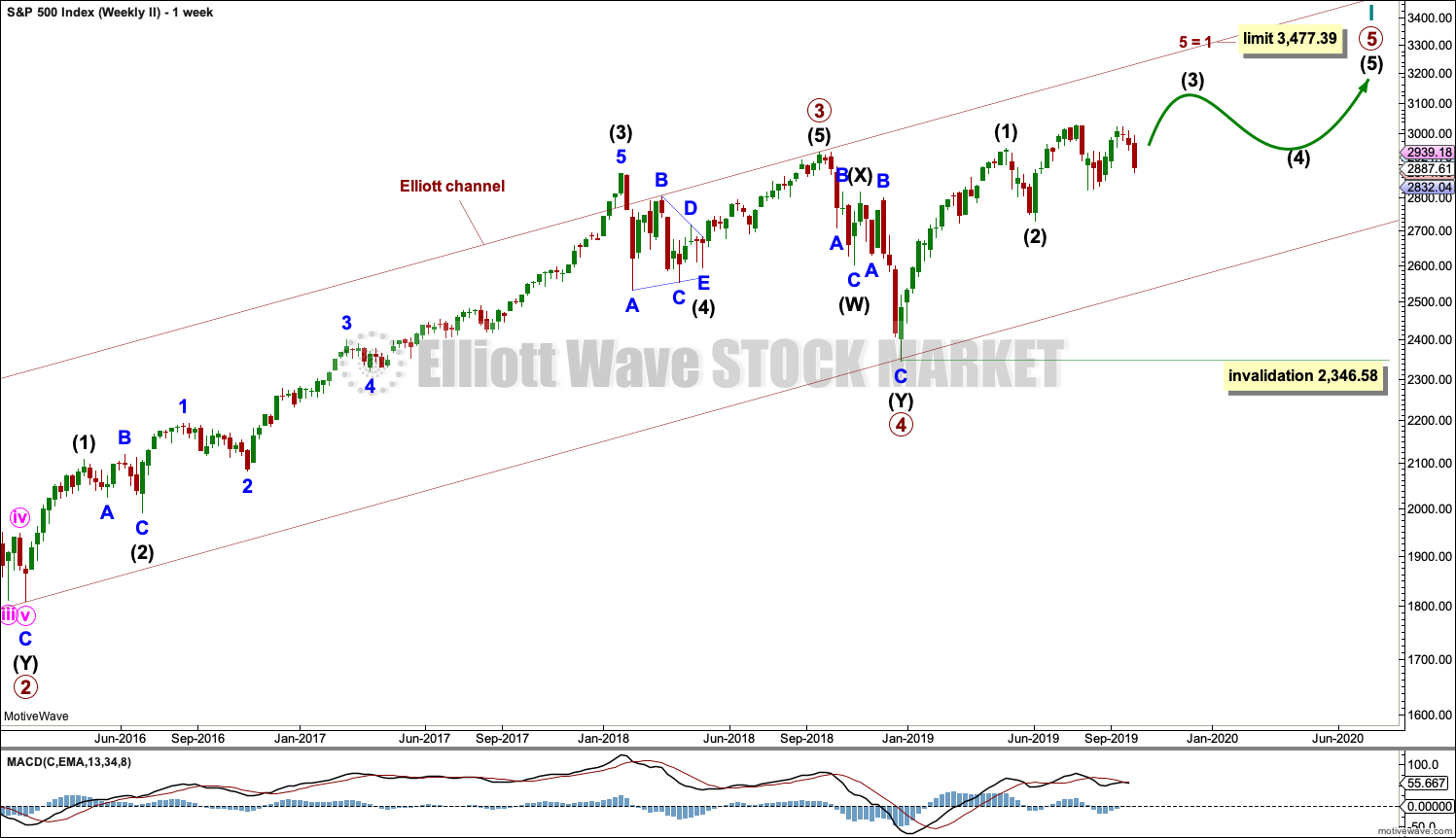
Main hourly updated:
Again, the pullback could be over. But lets see if there is strength in today’s upwards movement. It looks like this daily candlestick may complete a bullish Piercing pattern with a long lower wick. I’ll be considering the AD line, On Balance Volume and volume carefully.
Alternate hourly updated:
Minor 4 still to move sideways for a few days most likely. The 0.382 Fibonacci Ratio about here may be its highest point. Maybe a triangle? That would fit nicely and provide alternation. Or a combination, that could do the same.
The price point which clearly differentiates the two counts is absolute at 2,952.86.
My RUT long trigger fired. Entered once, stopped at BE, now in again…I’m being super defensive, I do not want to be holding anything underwater here.
BTW, I have today’s daily SPX and RUT candle wholly below my (lower) volatility bands.
The resistance at 2900 is/was real.
5 waves up from the bottom this morning, this is the (Elliott) definition of a trend.
Wait for a 3-wave correction, and hope the next wave up is a 3, not a C…
Yep…
Hey crammer,
Yesterday you wrote, “I get the impression that everyone here is bullish?”
This is just my two cents. I am not sure that is quite accurate. But there is no doubt a tilt that way because Lara’s counts indicate we are still in a bull market with upside to go. I have been a member here since very early 2012. One thing I have learned is that Lara is exceptional at what she does and to go against her is usually foolish. Another thing I have learned is that large corrections happen and often catch me unprepared. If you see my comment below, you will note that as of right now I am neutral and awaiting further data. But I have grave concerns this correction is just beginning.
Thanks for your comments and thanks to all who comment here. I appreciate your thoughts and insight.
I am neither bullish nor bearish. Much of the time I lean on Lara’s outlook. Right now the uncertainty is far too high; as I see it, the probabilities between her intermediate-term bullish vs. bearish models are far to close to 50-50 to do that. For many, this is a reasonable time to sit out, frankly. As someone said a day or two ago, it’s a market that can and will chop you up like liver.
that was meeee! still short but lightened up on that 200 day tap.
SPX’s down move now has excellent Fibonacci structure and the current hourly bar is a very strong bullish reversal bar. This might (might) be the end of this selloff.
this…
End of THIS sell-off, to clarify. After a bounce and some “backing and filling” in the upward direction, a fresh sell-off may very well commence. Perhaps late next week if/when tariff talks with China fail yet again. Those deeply in debt desperately want lower interest rates; ’nuff said. Stay nimble!! This is not an investor’s market.
I am thinking there is a high probability this is the end of this downward leg. I am looking for a 50% retrace back towards 2940. I want to see all the data between now and then before I adopt a longer term view. If we get wildly bullish data, then perhaps we have begun Intermediate 3 as per the main count. If not, I am concerned that we have just begun a recession and a bear market. If that is the case we will see SPX 2000 before we see SPX 3100. This next week or two is crucial.
I thought Lara said in one of her posts or videos (from about a week ago) that we can’t enter a recession/bear market for at least four months (i.e. end of January at the earliest).
I believe what you are referring to is as follows:
“Bear markets from the Great Depression and onwards have been preceded by an average minimum of 4 months divergence between price and the AD line with only two exceptions in 1946 and 1976. With the AD line making new all time highs again this week, the end of this bull market and the start of a new bear market is very likely a minimum of 4 months away, which is end January 2020.”
If a bear market develops then it would mean the 3rd exception is 2019, 43 years since its last occurrence. I have been relying on this fact with my bullish long positions. I hope it continues to be true. However, last evening another, much more bearish, alternate has been revived.
We can, but it is highly unlikely.
Markets can do whatever they like. The only information about their behaviour is the past. It’s an exercise in probability.
We could see a recession or even depression at any time. It’s just the underlying technical strength in this market at this time suggests its not quite yet ready for that. It’s a low probability outcome.
But then, the problem with low probability outcomes is that very occasionally they will occur. And when they do, they will never be what you expected to happen. Because that is the nature of probability.
Still, the alternate published today is the most bearish count I have been able to see to date. I simply have not been able to find a satisfactory count which sees the structure of Super Cycle wave (V) complete at the last ATH.
The general chart action similarities with Q4’18 are significant for me. And Q4’s bear period was due to what? Small interest rate increases and some language from Powell that spooked the markets. No actual data about economic issues whatsoever. This Q4 is totally different. There is actual Bad News, and a significant risk of Lots More Bad News on the economic front. I think the risks are very very high here. The future is not pre-determined; anything can happen. What actually happens in many geo-political/economic domains will drive what the market does. It’s not predictable. And right now, I’d suggest that it’s barely estimate-able. Stay nimble.
My understanding of Elliottwave is that it is not influenced by the news so we shouldn’t get caught up in the geo-political domains. Like in the video that Lara recommended we watch “History’s Hidden Engine”, it shows how the market was due to become bullish within a few days of 9/11/01. The event that happened that day was not the cause of the stock market rising soon thereafter, as it was going to happen anyway.
This article talks about how this Q4 market is similar to the one in 1998:
https://www.barrons.com/articles/the-good-news-is-the-same-as-the-bad-news-this-market-looks-just-like-1998-51569866319?refsec=economy-and-policy
Elliott wave modeling is not “influenced” in any way by fundamentals or news when done properly (the way Lara does it; my experience with other vendors of EW analysis is that some of the largest are very much influenced by their own sentiment). However, THE MARKET ITSELF is driven by fundamentals and news. And EW models are just models, nothing more. A basis for understanding price action and assessing probabilities of particular structures of near future price action. That’s my view anyway.
As traders, it’s always wise to assess potential for “surprises” that may hammer the market one way or the other. Sometimes that risk is lower. Sometimes it’s sky high. IMO, it’s sky high right now. My $0.02, trade safe and protect yourself at all times!
Re: the perspective “it was going to happen anyway”, my personal opinion is “absolutely not”. The implication is twofold: that the future is foreordained (NOPE!) and that an Elliot wave model predicts the future (NOPE!). Hopefully, my comments just above explain my objections. I don’t want to argue it, just present my viewpoint for your consideration.
Thanks Kevin. I definitely appreciate your viewpoint/analysis. I’m eager to learn and value your input.
And I don’t really follow much news. I do read local New Zealand stuff, but anything in particular to do with USA politics I do tend to avoid.
I’d rather read about Mrs Muggins cat stuck in a tree (we actually do get a fair few stories like that here with only 4.7 million people in the whole country) than politics in countries overseas.
Interesting article, thanks. I HOPE it is like 1998! I’d love a 68% rise going forward. I truly believe that if the US had nominal economic policies that would be exactly what would be happening now. We don’t have nominal economic policies and that makes a big difference. I don’t see a chance in heck of a major rise in equities here unless/until we get back to nominal economic policies. Which may be a long time in coming. So I see huge short term/intermediate term risk until those factors are resolved. Just my $0.02. As a result I focus on short term price action only, and try not to get too exposed or underwater through this rather “unusual” (a nice neutral term) period.
I agree with your sentiment. They certainly did their best to defend the 200 MA at the close. Seems medium term bullish for now.
Break of trend-line off Dec lows just might be probative…! Jobs report tomorrow will be interesting… 😉
Excellent follow through with second hourly candle, short term bull …
Strong 4 hour candles have been very helpful to trade against…
#1
Congratulations Kiran and welcome to the forum.